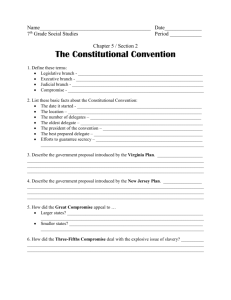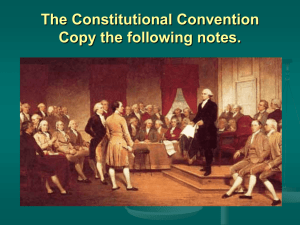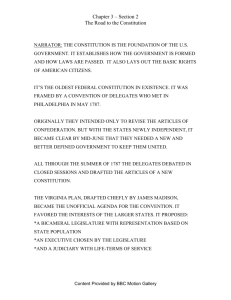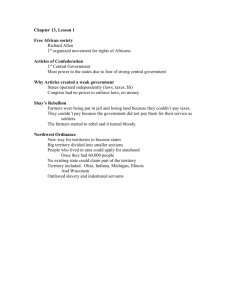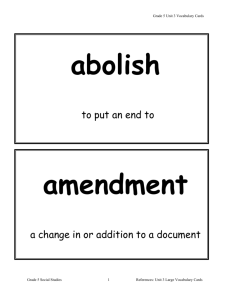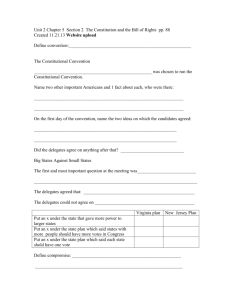the constitutional convention
advertisement
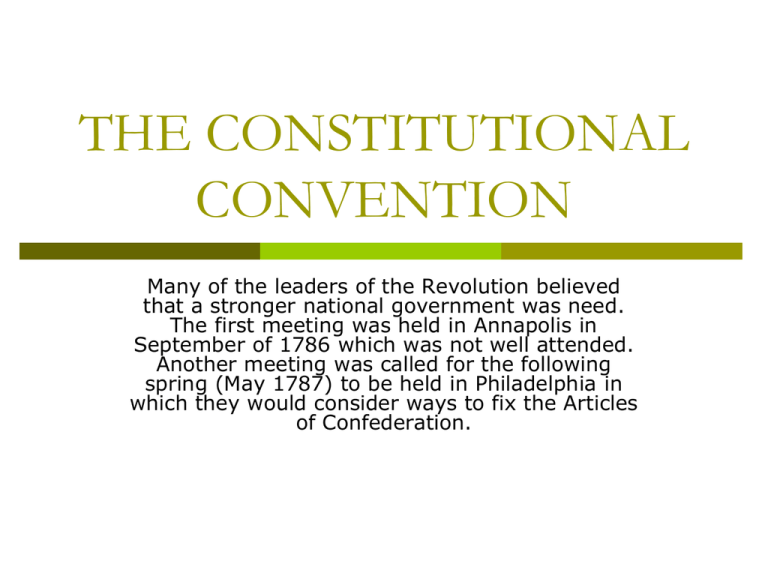
THE CONSTITUTIONAL CONVENTION Many of the leaders of the Revolution believed that a stronger national government was need. The first meeting was held in Annapolis in September of 1786 which was not well attended. Another meeting was called for the following spring (May 1787) to be held in Philadelphia in which they would consider ways to fix the Articles of Confederation. WHY THEY WERE THERE Many delegates came to the meeting convinced that the Articles were so bad that they needed to create a new plan of government James Madison had already drafted a plan for a new government before arriving at the Convention. As the Convention started the Virginia delegation, led by Edmund Randolph, presented to the convention the plan that Madison had drawn up. Four months later as the convention adjourned they had written a new constitution. THE VIRGINIA PLAN This plan proposed by Madison called for a strong national government organized into 3 governmental branches. This government would have the power to make and enforce its own laws Collect its own taxes Each citizen would be governed by two governments which would get their power from the people The existence of two governments each given a certain amount of authority over the people this is called federalism. MAKE UP OF THE CONVENTION Congress only gave the delegates of the convention the power to amend the Articles. 55 delegates attended the convention. May 1787 the delegates elected George Washington president of the convention. The delegates decided from the start to ignore their instructions to amend the Articles and instead voted to write a new Constitution Appointed a committee to draw up rules for the meeting They decided that what was said in the convention would be a secret. They believed the best constitution required a free exchange of ideas they believed that if delegates were afraid their debate would become public they would not express their real opinions They believed the new constitution would have a better chance of being accepted if people did not know about the arguments that went on while it was being written. Each state would only have one vote They agreed that a member could not be absent from the convention without permission if it deprived a state its vote Made it possible to reconsider issues freely No decision had to be permanent until the work was all done. VIRGINIA PLAN CONT. The fist branch of government was the legislative branch It was to be made up of two houses House of Representatives which would be elected directly by the people of each state Senate which would be elected by the members of the House of Reps from a list of nominated people by the state legislatures The number of representatives in both houses of the legislature would be based on the population of each state. Larger populated states would have more representatives Powers given to the legislature Make all laws that the states could not make (regulating trade between states) Supreme power on all matters The power to veto state laws that it considered to be in violation of the national constitution Call on the armed forces against a state to enforce the laws passed by congress EXECUTIVE & JUDICIAL BRANCHES Congress would elect the people to serve in the executive and judicial branches The executive could veto acts of the legislature but that veto could be overridden by the legislature REACTION TO THE VIRGINA PLAN The small states were worried that the Convention was creating a constitution in which the states would be represented in the legislature based on population. Why? The smaller states believed that they would always be outvoted by the larger states As a result the smaller states proposed their own plan for a new constitution led by William Paterson of New Jersey. This plan only amend the Articles NEW JERSEY PLAN Legislative Branch 1 house congress with equal representation for each state 1 vote Executive Branch The national government given the power to tax imports and a stamp tax to raise money for it operation The power to collect money from the states if they refused to pay Congress would be given the power to regulate trade among the states and other nations The laws and treaties made by congress would be the supreme law of the land. No state could make laws that were contrary to them Made up of several people appointed by Congress They would have the power to administer national laws, appoint other executive officials and direct the military Judicial Branch A supreme court would be appointed by the executive branch Power to decide cases involving treaties, trade among the states or other nations, and collection of taxes. GREAT COMPROMISE CONNECTICUT COMPROMISE A special committee was formed to draw up a plan to solve the problems that divided the delegates. House of Reps would be elected by the people on the basis of each states population Senate each state would have equal representation 2 The House of Reps. Would have the power to develop all bills for taxing and government spending The Senate was limited to either accepting or rejecting these bills but they could not change them this is later changed to allow the senate to amend tax bills and to develop appropriation bills


